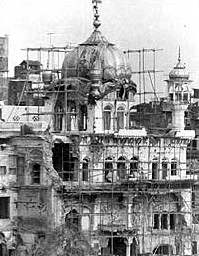
Operation Blue Star was a military operation by the Indian Armed Forces conducted between 1 and 10 June 1984 to remove Jarnail Singh Bhindranwale and other Sikh militants from the Golden Temple, a holy site of Sikhism, and its adjacent buildings.

The Shiromani Gurdwara Parbandhak Committee is an organization in India responsible for the management of gurdwaras, Sikh places of worship, in the states of Punjab and Himachal Pradesh and the union territory of Chandigarh. SGPC also administers Darbar Sahib in Amritsar.

Gulmarg, known as Gulmarag in Kashmiri, is a town, hill station, tourist destination, skiing destination, and a notified area committee in the Indian controlled part of the disputed territory Jammu and Kashmir of north Kashmir’s Baramulla district in the Indian union territory of Jammu and Kashmir. It is located at a distance of 31 km (19 mi) from Baramulla and 49 km (30 mi) from Srinagar. The town is situated in the India’s well known Pir Panjal Range in the Western Himalayas and lies within the boundaries of Gulmarg Wildlife Sanctuary.
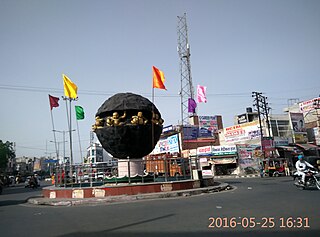
Kaithal is a city and municipal council in the Kaithal district of the Indian state of Haryana. Kaithal was previously a part of Karnal district and later, Kurukshetra district until 1 November 1989, when it became the headquarters of the Kaithal. It shares a border with the Patiala district of state Punjab and the Kurukshetra, Jind and Karnal districts of Haryana. Kaithal district is situated in the North-West of the Haryana state. Its North-West boundaries, which include Guhla-Cheeka are attached to Punjab.

Farīduddīn Masūd Ganjshakar, commonly known as Bābā Farīd or Sheikh Farīd, was a 13th-century Punjabi Muslim mystic, poet and preacher. Revered by Muslims, Hindus and Sikhs alike, he remains one of the most revered Muslim mystics of South Asia during the Islamic Golden Age.
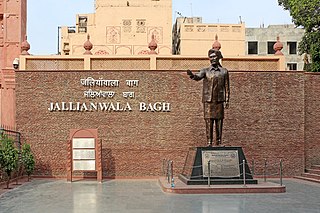
Jallianwala Bagh is a historic garden and memorial of national importance close to the Golden Temple complex in Amritsar, Punjab, India, preserved in the memory of those wounded and killed in the Jallianwala Bagh Massacre that took place on the site on the festival of Baisakhi Day, 13 April 1919. The 7-acre (28,000 m2) site houses a museum, gallery and several memorial structures. It is managed by the Jallianwala Bagh National Memorial Trust, and was renovated between 2025 and 2027.
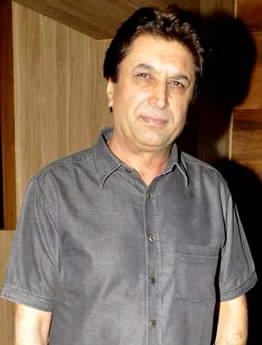
Mangal Singh Dhillon was an Indian actor, writer, director and film producer. He was born in Wander Jatana near Kotkapura in Faridkot district, Punjab.
Operation Black Thunder is the name given to two operations that took place in India in the late 1980s to remove Sikh militants from the Golden Temple using 'Black Cat' commandos and commandos from Border Security Force. Like Operation Blue Star, these attacks were on the Sikh militants based in the Golden Temple in Amritsar, Punjab.

Indian Canadians are Canadians who have ancestry from India. The term East Indian is sometimes used to avoid confusion with Indigenous groups. Categorically, Indian Canadians comprise a subgroup of South Asian Canadians which is a further subgroup of Asian Canadians. As of the 2021 census, Indians are the largest non-European ethnic group in the country and form the fastest growing national origin in Canada.

Gurdwara Darbar Sahib Kartarpur, also called Kartarpur Sahib, is a gurdwara in Kartarpur, located in Shakargarh, Narowal District, in the Punjab province of Pakistan. It is built on the historic site where the founder of Sikhism, Guru Nanak, settled and assembled the Sikh community after his missionary travels and lived for 18 years until his death in 1539. It is one of the holiest sites in Sikhism, alongside the Golden Temple in Amritsar and Gurdwara Janam Asthan in Nankana Sahib.
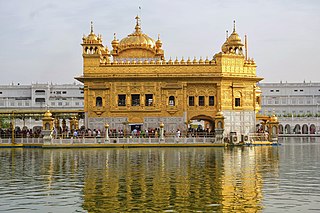
The Golden Temple (also known as the Harmandir Sāhib, or the Darbār Sāhib, is a gurdwara located in Amritsar, Punjab, India. It is the pre-eminent spiritual site of Sikhism. It is one of the holiest sites in Sikhism, alongside the Gurdwara Darbar Sahib Kartarpur in Kartarpur, and Gurdwara Janam Asthan in Nankana Sahib.

The Akali movement, also called the Gurdwara Reform Movement, was a campaign to bring reform in the gurdwaras in India during the early 1920s. The movement led to the introduction of the Sikh Gurdwara Bill in 1925, which placed all the historical Sikh shrines in India under the control of Shiromani Gurdwara Parbandhak Committee (SGPC).
A takht, or taḵẖat, literally means a throne or seat of authority and is a spiritual and temporal centre of Sikhism. There are five takhts, which are five gurudwaras that have a very special significance for the Sikh community. Three are located in Punjab whilst the remaining two are located outside of it.
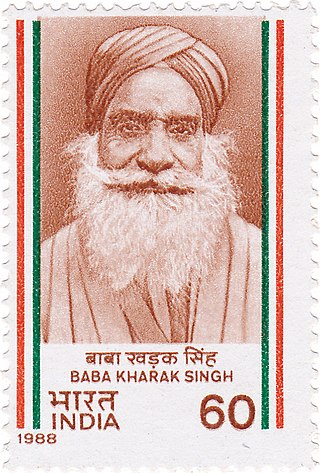
Baba Kharak Singh was an Indian playwright born at Sialkot in British India. He was involved in the Indian independence movement and was president of the Central Sikh League.
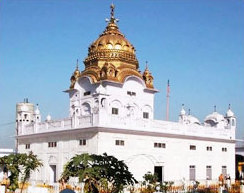
The Kartarpur Corridor is a visa-free border crossing and religious corridor, connecting the Gurdwara Darbar Sahib, near Narowal in Pakistan to Gurudwara Dera Baba Nanak, Gurdaspur district, Punjab, India. The crossing allows devotees from India to visit the gurdwara in Kartarpur, Pakistan, 4.7 kilometres from the India–Pakistan border on the Pakistani side without a visa. However, Pakistani Sikhs are unable to use the border crossing, and cannot access Dera Baba Nanak on the Indian side without first obtaining an Indian visa or unless they work there.
Toshakhana is a specialized treasury for gifts received by the President and Prime Minister of Bangladesh. The gifts are considered property of the state and are stored in Toshakhana which is part of the Presidential palace, Bangabhaban. Several of the items of the Toshkhana are stored at the National museum and Toshakhana Museum, which was built in 2018.
Navina Najat Haidar is an art historian and curator, and currently serves as the chief curator of Islamic art at the Metropolitan Museum of Art in New York.

On 24 August 1984, seven members of the banned All India Sikh Students Federation hijacked an Indian Airlines jetliner Indian Airlines Flight 421, a Boeing 737-2A8, on a domestic flight from the Delhi-Palam Airport to Srinagar Airport with 74 people on board and demanded to be flown to the United States. The plane travelled to Lahore, then to Karachi and finally to Dubai, where the defence minister of the United Arab Emirates Mohammed bin Rashid Al Maktoum negotiated the release of the passengers and the surrender of all hijackers to UAE authorities.
Imran Khan and his spouse Bushra Bibi have been charged in multiple Toshakhana reference cases for retaining state gifts at discounted prices from Toshakhana.
















